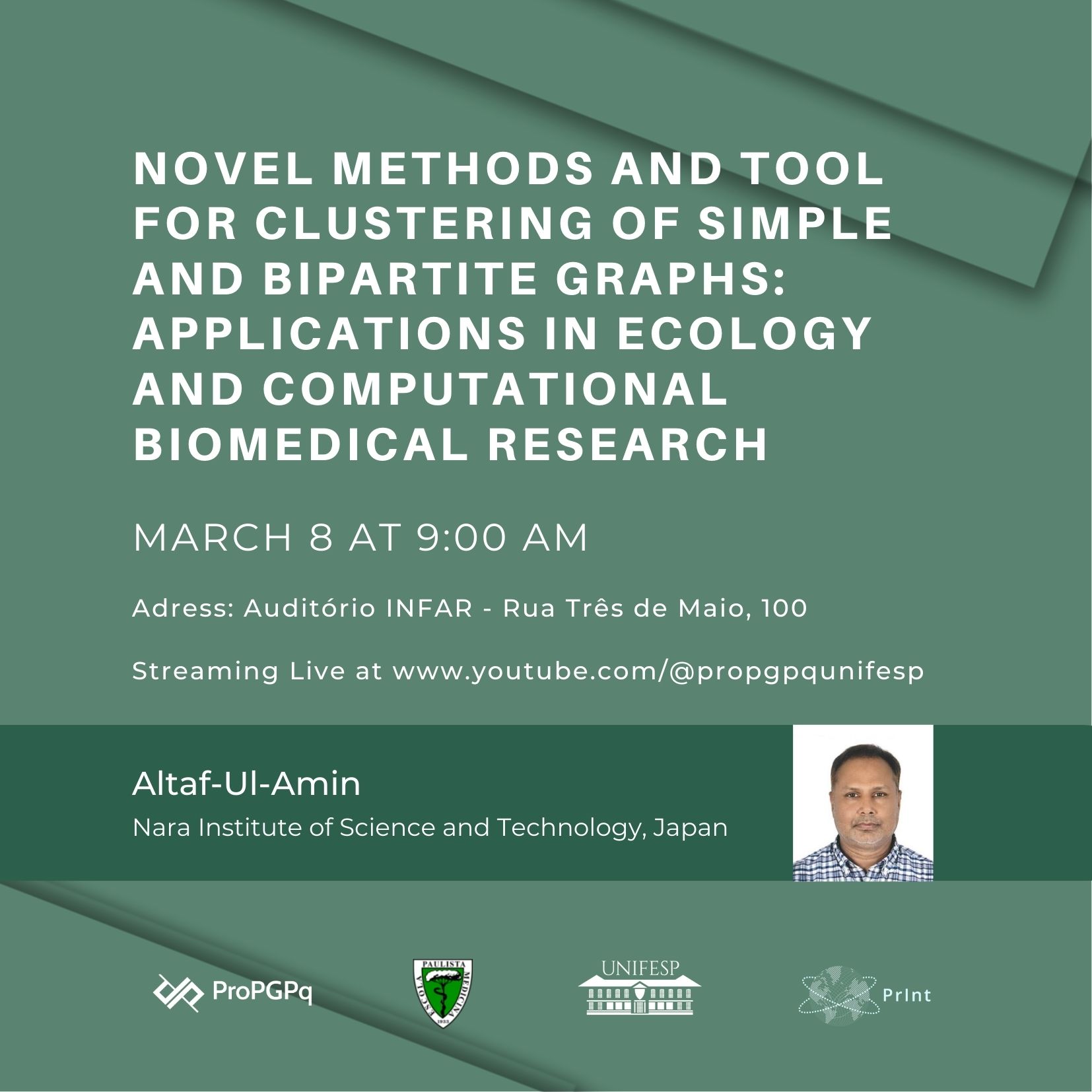On March 8, at 9 am
Speaker: Professor Md. Altaf-Ul-Amin, Associate Professor of Computational Systems Biology Lab of Nara Institute of Science and Technology (NAIST), Japan
Moderator: Mirian Hayashi, PhD, associate professor, Department of Pharmacology, Escola Paulista de Medicina - Unifesp
Link to watch the event: https://www.youtube.com/@propgpqunifesp

Abstract
Network analysis particularly graph clustering has become a useful and important technique in data mining applications. It provides a global view of data structure where highly concentrated data are grouped based on their common properties. Previously we developed graph clustering algorithms DPClus and DPClusO. Recently, we proposed a novel biclustering approach called BiClusO. We compared our biclustering algorithm with five different algorithms using biological and synthetic data and evaluated the performances. Our algorithm shows the best performance over the selected five biclustering algorithms. We also present new integrated software implementing the DPClusO and BiClusO algorithms to be utilized for simple and bipartite graph clustering. This tool provides the user with GUI based facilities for simple and bipartite graph clustering along with filtering and amalgamation facilities, hierarchical node analysis, node distribution among cluster set and visualization of all or partial portion of a big cluster set. We used this tool to analyze the bipartite relations between species and volatile organic compounds (VOCs). VOCs emitted by different species have huge environmental and ecological impacts. Biosynthesis of VOCs depends on different metabolic pathways based on which the species can be categorized. Our experiment shows that VOC based classification is consistent with taxonomy based classification of the species. Furthermore, we applied simple graph clustering algorithm DPClusO for finding inflammatory Bowel Disease(IBD) related genes. We also analyzed the mRNA and miRNA bipartite relations. In such relation a miRNA-regulatory module (MRM) is a subset of miRNA target interactions (MTI) where a group of miRNAs participate cooperatively by regulating a bunch of genes to control different biological processes. We mainly focused on MRMs detection from MTIs involving the IBD related genes. We evaluated the relevance of the miRNAs with IBD by counting their occurrences in different MRMs and their interactions with known IBD genes. Finally, we successfully identified some important IBD related miRNAs. Also, we will explain KNApSAcK database which has been developed in our lab.
Speaker further information:
Md. Altaf-Ul-Amin received B.Sc. degree in Electrical and Electronic Engineering from Bangladesh University of Engineering and Technology (BUET), Dhaka, M.Sc. degree in Electrical, Electronic and Systems Engineering from Universiti Kebangsaan Malaysia (UKM) and PhD degree from Nara Institute of Science and Technology (NAIST), Japan. He received the best student paper award in the IEEE 10th Asian Test Symposium. Also, he received two other best paper awards as a co-author of journal articles. He previously worked in several universities in Bangladesh, Malaysia and Japan. Currently he is working as an associate professor in Computational Systems Biology Lab of NAIST. He is conducting research on Network Biology, Systems Biology, Cheminformatics and Biological Databases. He published around 90 peer reviewed papers in international journals and conference proceedings. Current google scholar citation index of his publications is more than 7000.


